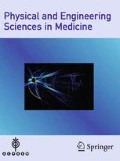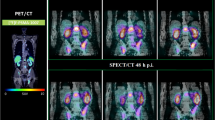Abstract
This study aims to investigate dose perturbations caused by a metallic biliary stent (MBS) in patients undergoing external beam radiotherapy for cancers in the pancreato-biliary region. Four MBSs with nitinol mesh were examined in the EasyCube® phantom including a custom stent holder fabricated by a 3D printer. For experimental models, three-dimensional conformal radiotherapy plans using a single anterior–posterior (AP) and four-field box (4FB) as well as volumetric modulated arc therapy (VMAT) plan were prepared to deliver the photon beam of 8 Gy to the stent holder. EBT3 film was used to measure dose distributions at four sides surrounding MBS. All MBSs in the AP beam demonstrated mean dose enhancements of 2.3–8.2% at the proximal, left, and right sides. Maximum dose enhancements of 12.3–19.5% appeared at regions surrounding the radiopaque markers. At the location distal to the source, there were mean dose reductions of − 3.6 to − 10.9% and minimum doses of − 11.1 to − 9.5%. The mean and maximum doses with the 4FB plan were in the ranges of − 0.1 to 3.6% and 6.7–14.9%, respectively. The VMAT produced mean doses of − 0.9 to 4.8% and maximum doses of 6.0–15.3%. Dose perturbations were observed with maximum and minimum spots near the stent surface. The use of multiple beams including parallel-opposed pairs reduced dose perturbations caused by the nitinol and radiopaque components within the stent. Special attention is required for patients in whom the radiopaque markers are closely located near critical structures or the target volume.






Similar content being viewed by others
References
Oettle H, Neuhaus P, Hochhaus A, Hartmann JT, Gellert K, Ridwelski K, Niedergethmann M, Zülke C, Fahlke J, Arning MB (2013) Adjuvant chemotherapy with gemcitabine and long-term outcomes among patients with resected pancreatic cancer: the CONKO-001 randomized trial. JAMA 310(14):1473–1481
Li D, Xie K, Wolff R, Abbruzzese JL (2004) Pancreatic cancer. Lancet 363(9414):1049–1057
Beltrán MB, Allal AS, Gich I, Solé JM, Carrió I (2012) Is adjuvant radiotherapy needed after curative resection of extrahepatic biliary tract cancers? A systematic review with a meta-analysis of observational studies. Cancer Treat Rev 38(2):111–119
Hsu CC, Herman JM, Corsini MM, Winter JM, Callister MD, Haddock MG, Cameron JL, Pawlik TM, Schulick RD, Wolfgang CL (2010) Adjuvant chemoradiation for pancreatic adenocarcinoma: the Johns Hopkins Hospital—Mayo Clinic collaborative study. Ann Surg Oncol 17(4):981–990
Glinka J, Diaz F, Alva A, Mazza O, Claria RS, Ardiles V, de Santibañes E, Pekolj J, de Santibañes M, Roj J (2018) Use of radiotherapy in patients with palliative double bypass for locally advanced pancreatic adenocarcinoma. Radiat Oncol J 36(3):210–217
Atwood TF, Hsu A, Ogara MM, Luba DG, Tamler BJ, DiSario JA, Maxim PG (2012) Radiotherapy dose perturbation of esophageal stents examined in an experimental model. Int J Radiat Oncol Biol Phys 82(5):1659–1664
Chen YK, Schefter TE, Newman F (2011) Esophageal cancer patients undergoing external beam radiation after placement of self-expandable metal stents: is there a risk of radiation dose enhancement? Gastrointest Endosc 73(6):1109–1114
Li XA, Chibani O, Greenwald B, Suntharalingam M (2002) Radiotherapy dose perturbation of metallic esophageal stents. Int J Radiat Oncol Biol Phys 54(4):1276–1285
Dayyeh BA, Vandamme J, Miller RC, Baron TH (2013) Esophageal self-expandable stent material and mesh grid density are the major determining factors of external beam radiation dose perturbation: results from a phantom model. Endoscopy 45(1):42–47
Francis SR, Anker CJ, Wang B, Williams GV, Cox K, Adler DG, Shrieve DC, Salter BJ (2013) Self-expanding stent effects on radiation dosimetry in esophageal cancer. J Appl Clin Med Phys 14(4):121–135
Tsuji Y, Yoshimura H, Uto F, Tamada T, Iwata K, Tamamoto T, Asakawa I, Shinkai T, Kichikawa K, Hasegawa M (2007) Physical and histopathological assessment of the effects of metallic stents on radiation therapy. J Radiat Res 48(6):477–483
Elhammali A, Patel M, Weinberg B, Verma V, Liu J, Olsen JR, Gay HA (2015) Late gastrointestinal tissue effects after hypofractionated radiation therapy of the pancreas. Radiat Oncol 10(1):1–8
Marks LB, Yorke ED, Jackson A, Ten Haken RK, Constine LS, Eisbruch A, Bentzen SM, Nam J, Deasy JO (2010) Use of normal tissue complication probability models in the clinic. Int J Radiat Oncol Biol Phys 76(3):S10–S19
Cho B (2018) Intensity-modulated radiation therapy: a review with a physics perspective. Radiat Oncol J 36(1):1
Pfau PR, Pleskow DK, Banerjee S, Barth BA, Bhat YM, Desilets DJ, Gottlieb KT, Maple JT, Siddiqui UD, Tokar JL (2013) Pancreatic and biliary stents. Gastrointest Endosc 77(3):319–327
Dumonceau J-M, Heresbach D, Devière J, Costamagna G, Beilenhoff U, Riphaus A (2011) Biliary stents: models and methods for endoscopic stenting. Endoscopy 43(07):617–626
Kim M-J, Lee S-R, Lee M-Y, Sohn JW, Yun HG, Choi JY, Jeon SW, Suh TS (2017) Characterization of 3D printing techniques: toward patient specific quality assurance spine-shaped phantom for stereotactic body radiation therapy. PLoS ONE 12(5):e0176227
Kamomae T, Shimizu H, Nakaya T, Okudaira K, Aoyama T, Oguchi H, Komori M, Kawamura M, Ohtakara K, Monzen H (2017) Three-dimensional printer-generated patient-specific phantom for artificial in vivo dosimetry in radiotherapy quality assurance. Phys Med 44:205–211
Yoon J, Park K, Kim JS, Kim YB, Lee H (2019) Skin dose comparison of cyberknife and helical tomotherapy for head-and-neck stereotactic body radiotherapy. Prog Med Phys 30(1):1–6
Park J, Yea JW (2019) Whole brain radiotherapy using four-field box technique with tilting baseplate for parotid gland sparing. Radiat Oncol J 37(1):22–29
Niroomand-Rad A, Blackwell CR, Coursey BM, Gall KP, Galvin JM, McLaughlin WL, Meigooni AS, Nath R, Rodgers JE, Soares CG (1998) Radiochromic film dosimetry: recommendations of AAPM radiation therapy committee task group 55. Med Phys 25(11):2093–2115
Dreindl R, Georg D, Stock M (2014) Radiochromic film dosimetry: considerations on precision and accuracy for EBT2 and EBT3 type films. Z Med Phy 24(2):153–163
ICRU Report 83 (2010) Prescribing, recording, and reporting photon-beam intensity-modulated radiation therapy (IMRT) 10. Oxford University Press, Oxford
Mayo-Smith WW, Dawson SL, Mauceri T, Mueller PR (1996) Attenuation effects of biliary endoprostheses on therapeutic radiation. Radiology 199(2):571–572
Funding
This research was supported by a Grant of the Radiation Technology R&D program through the National Research Foundation of Korea funded by the Ministry of Science, ICT & Future Planning (2017M2A2A6A01070330).
Author information
Authors and Affiliations
Corresponding author
Ethics declarations
Conflict of interest
The authors declare that they have no conflict of interest.
Ethical approval
This article does not contain any studies with human participants or animals performed by any of the authors.
Additional information
Publisher's Note
Springer Nature remains neutral with regard to jurisdictional claims in published maps and institutional affiliations.
Rights and permissions
About this article
Cite this article
Lee, H., Yoon, J., Park, K. et al. Dose perturbation by metallic biliary stent in external beam radiotherapy of pancreato-biliary cancers. Australas Phys Eng Sci Med 42, 745–756 (2019). https://doi.org/10.1007/s13246-019-00774-1
Received:
Accepted:
Published:
Issue Date:
DOI: https://doi.org/10.1007/s13246-019-00774-1




